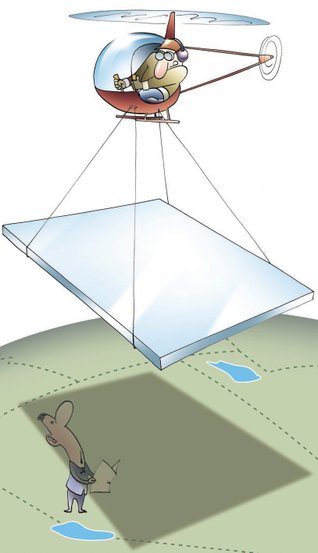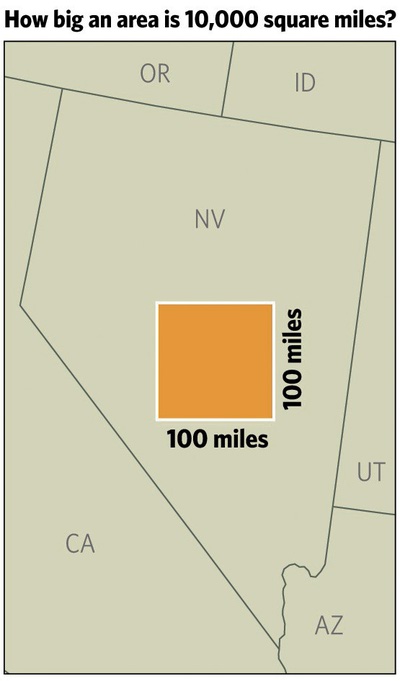Sunday, April 5, 2009 | 2 a.m.
Enlargeable graphic: How large is 10,000 square miles?
Sun Archives
- Solar firm sees bright future here (3-27-2009)
- Solar developers shoot to beat buzzer for cash (3-22-2009)
- Small-scale solar seeks incentives (3-16-2009)
- State faces obstacles to cashing in on the sun (3-9-2009)
- NV Energy asks about stopping renewable fees (2-27-2009)
- Solar company to focus on manufacturing (2-23-2009)
- Green can fatten Nevadans' wallets, too (8-20-2008)
People unfamiliar with Nevada’s vast desert often find it more difficult to see what is there than to imagine what could be superimposed on the seemingly endless landscape.
Nuclear waste wedged inside a mountain.
Towering mushroom clouds.
A network of nuclear missiles covering 10,000 square miles.
These days, a very different image is evoked for 10,000 square miles of Nevada desert: a 100-mile-by-100-mile square of solar panels, enough to furnish the entire country with electricity.
The image is a metaphor, not a plan.
It has been evoked for over a decade, repeated by scientists, solar promoters, politicians and journalists. As renewable energy has become more popular, so has the vision of a swath of Nevada blanketed with shining solar panels.
A scientist named Roland Hulstrom, now acting director of photovoltaic solar for the National Renewable Energy Laboratories, came up with it.
About a dozen years ago, scientists at the Denver-based laboratories were growing frustrated by a common but misinformed notion that the country could never rid itself of gas and coal power because the alternatives would take up too much land.
Hulstrom set out to prove that the shift to renewable energy wouldn’t require paving over the entire country with solar panels. It would merely take up the equivalent of about 11 percent of Nevada.
Hulstrom calculated the figure based on the nation’s energy use, the efficiency of solar panels and the amount of sunlight drenching the desert. To a Power Point presentation on solar energy, he added a picture of the state of Nevada with a giant square in the middle to represent the area.
In 1999, John Turner, another National Renewable Energy Laboratories scientist, published the calculations in Science Magazine. Eventually the idea made its way onto the Department of Energy Web site. The media began to repeat the idea, beginning in a 2001 National Public Radio interview with a solar lobbyist.
A star factoid was born. The only downside: In the retelling, people sometimes incorrectly state the size of the area.
Over the years the calculations have been updated to reflect increases in the nation’s energy consumption and the efficiency of solar technology. Renewable Energy Laboratories spokesman George Douglas said the calculations were last done in 2005.
Conveniently, the result has stayed the same. As energy consumption increased, so, too, did the efficiency of solar panels.
It could have been anywhere in the Southwest, Douglas said. Hulstrom chose Nevada not for the usual reasons the state becomes a proposed home for schemes — the land can look like a blank slate, the federal government owns 86 percent of the state.
Instead, Douglas said, Hulstrom chose Nevada because gauges at the Nevada Test Site were measuring the area’s solar potential. That made the calculations easier.
The idea was never intended to be taken literally.
“It’s not a serious proposal for a dozen different reasons,” Douglas said. “Imagine the size of the transmission lines. It would be ridiculous. And think of national security. One spot goes and the whole country goes dark.”
Instead, Douglas likes to take the imagined a step further. The giant solar square in the desert explodes into thousands of little pieces lighting up the entire country.
“That’s the beauty of solar — that you don’t have to have it all in one place,” Douglas said. “It’s just a way of helping people visualize in the vast scheme of things what this quantity actually looks like.”
The image, however, is relevant as Nevada contemplates whether to build big or small as it seeks to become a solar powerhouse.
No one is proposing a single site here that approaches 10,000 square miles, or even 100 square miles. The largest plant so far is 0.4 square miles, but projects that would consume more desert are in the planning stages.
As of January, 1,127 square miles of solar plants have been proposed in applications to the Bureau of Land Management. The largest single project would take up 48 square miles.
Depending on their location, utility-scale projects are likely to be controversial with some rural Nevada residents. In addition to the utility-scale projects, some in the solar industry would like to encourage more small-scale projects erected where the energy is consumed.
“People always say there’s nothing out there in the desert, so let’s put solar and everything else,” said Rob Mrowka, conservation advocate of the Center for Biological Diversity, who favors solar plants in certain desert locations. “They don’t think about the richness that does exist in the desert and the vistas, the openness, the spiritual values people get from that openness.”
Back in Denver, Douglas and others at Renewable Energy Laboratories are pleased that the image has helped people understand the nation’s energy equation, but they wonder how many times they have to say it: It’s 100 miles square, not 100 square miles.



Join the Discussion:
Check this out for a full explanation of our conversion to the LiveFyre commenting system and instructions on how to sign up for an account.
Full comments policy